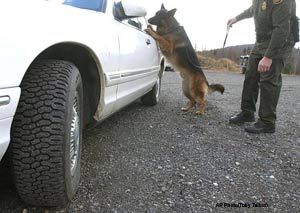Violence attributed to the rise of powerful street drugs such as crack cocaine and methamphetamine.
By Melissa Patterson
The Orlando Sentinel
 These days it’s not uncommon for K9s to suffer gunshots, stab wounds and other injuries. (AP Photo/Toby Talbot) |
ORANGE COUNTY, Fla. — Halo the Orange County sheriff’s dog came away with a split nose, bloodshot eyes and a swollen face after an encounter early Wednesday with a fleeing suspect.
His handler, Sgt. Jeff Doyle, was grateful.
It could have been worse — like the partially separated shoulder a suspect gave Halo in February. Or the gunshots, stab wounds and other injuries Central Florida police dogs are suffering these days.
Ten years ago, wounds like these were almost unheard of, said Orange County Cmdr. Sandy Carpenter, who oversees the K-9 unit.
“When we caught you with a dog, that was it. The fight was over,” Carpenter said. “In today’s world, with the violent offenders, we’re seeing that’s just the beginning of the fight.”
The Orange-Osceola State Attorney’s Office has received only three cases of police-animal battery this year.
Yet the Underhill Animal Hospital in Orlando sees at least one attack injury per month in treating 60 to 80 police dogs from Orange, Seminole and Osceola law-enforcement agencies.
Trauma from kicking and punching is the most common, said veterinarian Dr. Dan Hill, but the hospital also sees torn nails, choking injuries and wounds to the eyes from gouging or pepper spray.
It’s nothing Hill doesn’t see in other pet-abuse cases. But when it comes to police dogs, Hill and his office play an integral role in treating injuries suffered in the line of duty in order to keep the dogs’ careers alive.
“The tears I shed for a mutt are the same type of tears I shed for a police dog,” Hill said. “But I guess I feel more urgent about getting a police dog back on the street than for a Pomeranian to play Frisbee in the backyard.”
The risks to police dogs can be high. Diogi, a German shepherd with the Polk County Sheriff’s Office, was gunned down a year ago alongside Deputy Vernon “Matt” Williams after a traffic stop.
In May, a Leesburg man was charged with trying to choke Jan, a Lake County sheriff’s dog. Choking can end a dog’s career -- it’s one of the most disabling injuries they suffer, Hill said.
Halo suffered cuts and bruises but no permanent injury in his scuffle with an underage drinking suspect, who is accused of punching him repeatedly in the face, probably while wearing a ring.
Zachary Nimhauser, 18, fled by jumping into a retention pond after he and another man were stopped near University Boulevard and Alafaya Trail, the Florida Highway Patrol said. After a two-hour pursuit, Nimhauser tried to escape through a hotel parking lot, where Halo took him down.
After the incident, Doyle shot photos of the deep gash on Halo’s nose, to help his case.
On top of charges of battery on a law-enforcement officer and resisting an officer, Doyle said he would seek misdemeanor charges for police-dog battery. Nimhauser was being held at the Orange County Jail.
Few assaults on police dogs lead to charges, despite laws allowing up to five years in prison if a suspect causes “great bodily harm” to an animal.
Witnessing an injury is one thing, but proving it is a different matter, Doyle said, because many wounds aren’t noticeable for days or months. Hill said one dog he treated had a bullet lodged in his chest that no one detected for six months.
The Orange Sheriff’s Office has three bloodhounds and 16 German sherpherds assigned to handlers. Halo, dubbed Doyle’s “little guardian angel” by his wife, is 41/2 years old and hails from Hamburg, Germany. This is his third injury sustained in less than three years in the line of duty.
Many police dogs go their whole five- to seven-year careers without any injuries, except those suffered while traveling through rough terrain, known as tracking injuries, Hill said. He sees those weekly.
Snake bites, torn footpads and scratches are relatively common, but the number of apprehension injuries -- usually inflicted by suspects on the run -- has skyrocketed.
It’s no longer a situation where the suspects are trying “to resist the dog’s pressure,” Doyle said. “It’s now where they’re trying to injure the dog so they can escape.”
Hill attributes the violence to the rise of powerful street drugs such as crack cocaine and methamphetamine.
Others have theorized that more officers and dogs pursuing suspects mean more injuries sustained during pursuits.
Carpenter, the Orange K-9 commander, said police dogs often get a bad rap for being vicious, when they’re merely trained to clamp down on a suspect to immobilize him.
The suspect in Wednesday’s chase suffered mild injuries to the leg, which could have been avoided entirely if he had surrendered, Carpenter said.
“Bad guys need to get a clue and learn that they will never win against a K-9 cop,” said Diane Anderson, a pet behaviorist with the Orlando Humane Society. “Stand still and don’t fight them; you will lose.”
Copyright 2007 Orlando Sentinel

